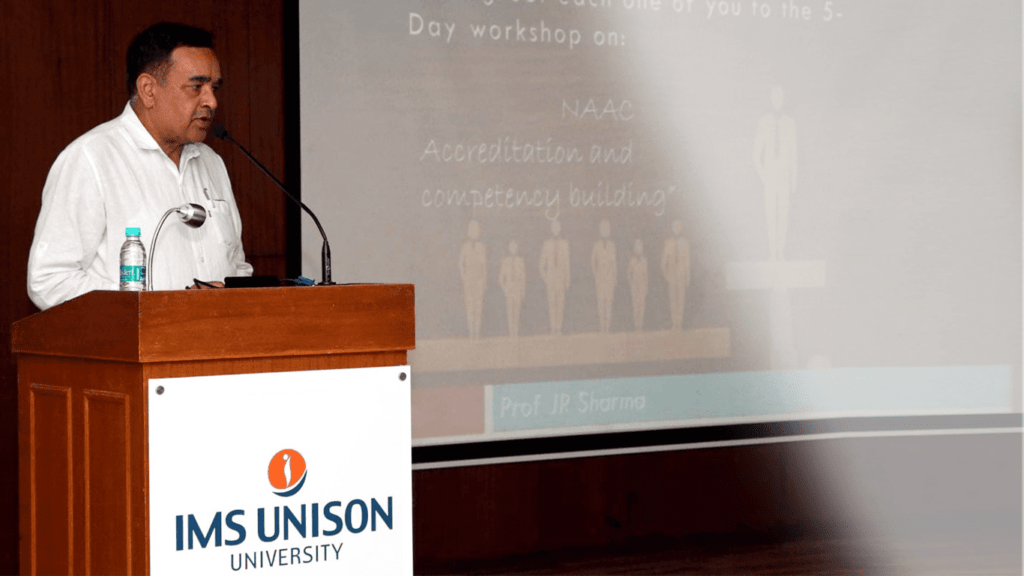
Prof Sharma is amongst a handful of pioneers to get NBA mandated outcome-based education system implemented in various HEIs in India. It is his expertise in NBA accreditation that holds him in an incredible uplifting perception of HEIs as one amongst the top accreditation consultants in India. He was invited by the NBA authorities to speak at the 3rd World Summit on Global Best Practices in Accreditation, held in India in the year 2016 with attendance of over 1200 delegates from nearly all Washington Accord countries.
He is arguably, the most travelled Consultant in India on the invitation of various institutes. He has guided faculty of over 82 HEIs, till date, some of whom are leading universities of India such as BITS Pilani. Amity University, NSIT and others for a sustained long period of time for further enriching their engineering programs.
“The Consultancy is delivered over a period of 6 months, led by Prof Sharma and spanned over 10 to 15 visits to the campus. Each visit comprises of 5 hours of intense engagement. A large number of institutes do also seek services for workshops, mock inspections and Annual Academic Audits, each of 3-day engagement”
Why NBA Consultancy?

- Faculty in the colleges and universities have their larger focus to pure academics. Some eminent ones are research intensive, as well. The dynamics of these institutes don’t allow enough time for faculty to immerse themselves into the accreditation system and documentation. This keeps them little informed on expectations by the NBA and are unable to do full justice.
- Assessment and Evaluation process of ‘outcome-based education’ is a bit complex in nature. Experience reveals that over 90% institutes don’t know how to arrive at the direct, indirect assessment leading to attainment of POs, PSOs and ultimately PEOs. Unfortunately, the NBA accreditation documents don’t provide end-to-end solutions. They leave it for Institutes to devise it. Our consultants have a complete mastery over it..
- “First Year” documentation of Outcome-based education in UG Engineering is inadequately explained in the NBA SSR. It leaves institutes into confusion for a lack of complete clarity on attainment of PEOs, POs and PSOs.
- There is no suggested format by NBA for the ‘Indirect Assessment’. Institutes need to establish a well thought-out system that is fully justifiable. It needs an expert’s input.
- Institutes might or might not have the NBA mandated policies for the desired initiatives/process. In some cases, a policy might simply not meet all the required aspects. In other cases, the implementation and impact analysis could be missing.
- The implementation of outcome-based system must ultimately result into improvement of curriculum, academic and physical support systems, enhanced hard outcomes and better governance of the institute. We don’t find even 5% institutes undertaking this essential exercise of outcome-based-education which in fact is the true outcome of the system.
If you are looking for a most experienced and best accreditation consultant at work, AccreditationEdge should undoubtedly be your first and final choice.
7 Step Clarity in documenting OBE Process
f you didn’t do OBE documentation side by side your teaching -learning, this is one possible way you can document your past deliverables:-
Step-1: To get hold of all assessment marks of the two passed out batches, course-wise and examine how the same have been further broken down into test/assignment-wise in each course.
Step 2: Each Course has Course Outcomes like CO-1, CO-2 etc. Question papers and assignments need to match and meet Course Outcomes (marks converted into levels of 3,2,1) based on 60% students attaining set threshold level (threshold level of each course differs from each other due to the relative difficulty of a course and is an average of the past 3 years marks. Now decide levels ..60% students attaining the set threshold % :-Level-1 similarly 70% students ….level 2 and 80% students … level 3. Please remember it is the % of students and NOT % of marks meeting the threshold.
Step 3: Take out an average of all the Course Outcomes of a course and arrive at the overall
Level of a Course up to two decimal points. Similarly, go on doing for all the courses of the batch. For example, in PGDM it is a 2-year batch.
Please note that POs are attained after factoring-in assessment of a full batch and NOT pertaining to a single academic year, alone.
Step 4: Based on the courses mapped with a specific PO, add up the levels (upto 2 decimal level) of all courses, relevant to the specific PO and arrive at an average figure of the PO attainment to two decimal points. Like-wise, go for all the POs attainment to two decimal levels.
The above will be direct assessment comprising 80% weight-age.
Step 5: Take average of the batch on indirect assessment (surveys etc.) duly converted into the scale of 3. Give it 20% weight. Ensure indirect assessment documents attached as Annexure.
Step 6: Now add Direct and Indirect Assessment and arrive at the final average figure of each PO attainment up to two decimal points.
Step 7: Compare outcomes of POs of at least two passed out batches and draw a graph. It would reveal whether one Batch had a better or worse PO attainments than the other, and document the reasons thereof.
Imp: The most essential and basic part of this process is to set question papers/conduct assignments and allocate marks weightage squarely based on Course Outcomes.
Prof JR Sharma- a Mentor
The above are my personal and summary interpretations of the NBA SAR for the larger good of HEIs, applying for the NAAC and NBA accreditations.










